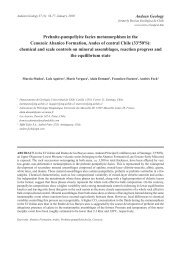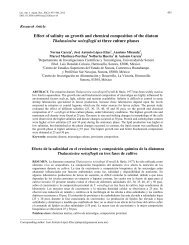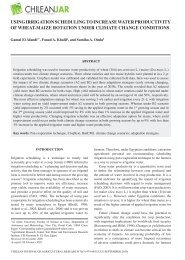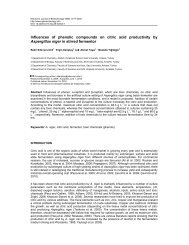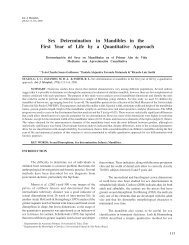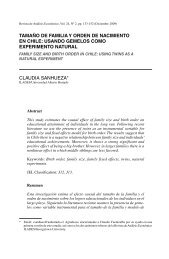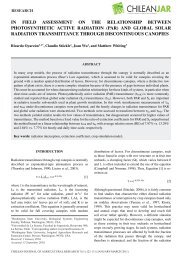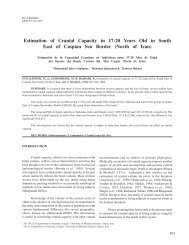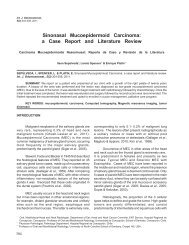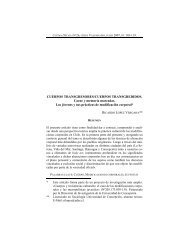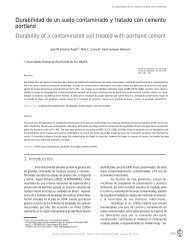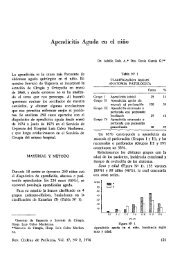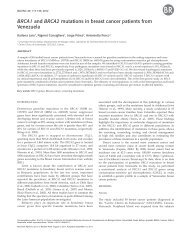In vitro fruit trees rooting by Agrobacterium rhizogenes wild ... - SciELO
In vitro fruit trees rooting by Agrobacterium rhizogenes wild ... - SciELO
In vitro fruit trees rooting by Agrobacterium rhizogenes wild ... - SciELO
Create successful ePaper yourself
Turn your PDF publications into a flip-book with our unique Google optimized e-Paper software.
EJB Electronic Journal of Biotechnology ISSN: 0717-345 Vol.1 No.2, Issue of August 15, 1998.<br />
© 1998 <strong>by</strong> Universidad Católica de Valparaíso –- Chile <strong>In</strong>vited review paper/ Received 20 October, 1998.<br />
RESEARCH ARTICLE<br />
<strong>In</strong> <strong>vitro</strong> <strong>fruit</strong> <strong>trees</strong> <strong>rooting</strong> <strong>by</strong> <strong>Agrobacterium</strong> <strong>rhizogenes</strong> <strong>wild</strong> type infection<br />
Carmine Damiano 1<br />
Fruit Trees Research <strong>In</strong>stitute, 00040 Ciampino Aeroporto - Roma, Italia.<br />
Financial support: National Plan for Plant Biotechnology, Ministry of Agriculture<br />
Fruit Trees Research <strong>In</strong>stitute, 00040 Ciampino Aeroporto - Roma, Italia.<br />
Tel + 39 06 7934811- Fax +39 06 79340158<br />
E-mail: isf.propag@mclink.it<br />
Simona Monticelli<br />
Fruit Trees Research <strong>In</strong>stitute, 00040 Ciampino Aeroporto - Roma, Italia.<br />
Financial support: National Plan for Plant Biotechnology, Ministry of Agriculture<br />
Fruit Trees Research <strong>In</strong>stitute, 00040 Ciampino Aeroporto - Roma, Italia.<br />
Tel + 39 06 7934811- Fax +39 06 79340158<br />
http://www.inea.it/isf/index.html<br />
<strong>Agrobacterium</strong> <strong>rhizogenes</strong> infection at the base of<br />
microcuttings in <strong>vitro</strong> can improve the <strong>rooting</strong> of some <strong>fruit</strong><br />
species. A study was carried out comparing <strong>rooting</strong> of<br />
almond, apple, plum, Pyrus pyraster and two hybrid<br />
rootstocks, when infected with A. <strong>rhizogenes</strong> strain 1855,<br />
with and without the addition of hormones. Three<br />
responses occurred: genotypes rooted without auxins;<br />
genotypes rooted only with auxins; genotypes rooted only<br />
after infection. All genotypes rooted after bacterial<br />
infection. <strong>In</strong> the first group the auxins increased <strong>rooting</strong><br />
percentages. No substantial differences were found with<br />
and without infection in hormone free media, while the<br />
<strong>rooting</strong> percentages tended to decrease with the<br />
combination auxin/infection. <strong>In</strong> the second group, infection<br />
on hormone free media increased <strong>rooting</strong>; in addition there<br />
was a synergistic effect between auxins and infection in<br />
pears. <strong>In</strong> the third group, only infection induced <strong>rooting</strong>. A<br />
random sample of roots obtained from infection was<br />
molecularly analysed. Amplification of the sequences of<br />
rolB and vir genes was done using PCR. Roots nontransgenic<br />
and confirmed as transgenic were 67 % and 6.8<br />
% respectively. <strong>In</strong> the remaining 26.2% both genes<br />
appeared, thus it was not possible to confirm their<br />
transgenic nature. Some microcuttings showed both<br />
transformed and non-transformed roots.<br />
Abbreviations: BAP, 6-benzylaminopurine; IAA, indoleacetic acid; NAA,<br />
αnaphthaleneacetic acid; IBA, indole-3-butyric acid; GA3, gibberellic acid; PCR,<br />
polymerase chain reaction; EtBr, ethidium bromide; YMB, yeast-extract mannitol<br />
broth; MS, Murashige and Skoog medium; SH, Schenk and Hildebrandt ; QL,<br />
Quoirin and Lepoivre.<br />
Many woody plants, economically important for timber and/or<br />
<strong>fruit</strong> production, are often difficult to root, both in conventional<br />
and in <strong>vitro</strong> propagation. <strong>In</strong> some cases, it was possible to<br />
improve in <strong>vitro</strong> <strong>rooting</strong> with hormone application, etiolation,<br />
or the use of polyamines (Damiano et al., 1991; Rugini et al.,<br />
1993). However, the difficulty of <strong>rooting</strong> is still one of the<br />
major obstacles to successful micropropagation. Recently,<br />
many attempts to overcome this problem have been carried out<br />
on <strong>fruit</strong> <strong>trees</strong> and woody species using <strong>Agrobacterium</strong><br />
<strong>rhizogenes</strong>. This is a soil gram-negative bacterium that<br />
induces adventitious root formation at the site of infection in a<br />
large number of plants (Chilton et al., 1982). Root induction is<br />
due to the integration and subsequent expression of a portion<br />
of bacterial DNA (T-DNA) from the Ri (Root <strong>In</strong>ducing)<br />
plasmid in the plant genome. Four loci involved in the root<br />
formation were identified in the T-DNA, and called root loci<br />
(rol) A, B, C, D (Spena et al., 1987).<br />
Several authors reported successful <strong>rooting</strong> using<br />
<strong>Agrobacterium</strong> <strong>rhizogenes</strong>-mediated transformation in <strong>fruit</strong><br />
<strong>trees</strong>, such as almond (Damiano et al., 1995), apple (Sutter<br />
and Luza, 1993), kiwi (Rugini et al., 1991), walnut (Caboni et<br />
al., 1996), and in woody plants, such as the genus Pinus<br />
(McAfee et al., 1993; Magnussen et al., 1994; Mihalievic et<br />
al., 1996; Burns and Schwarz, 1996; Tzfira et al., 1996), Larix<br />
(McAfee et al., 1993), Eucalyptus (MacRae and Van Staden,<br />
1993). The transformation of microcuttings and seedlings <strong>by</strong><br />
A. <strong>rhizogenes</strong> seems to be an excellent way to improve <strong>rooting</strong><br />
in <strong>trees</strong>. The aim of this work is to determine the ability of A.<br />
<strong>rhizogenes</strong> to induce root formation on different species and<br />
genotypes of micropropagated <strong>fruit</strong> <strong>trees</strong>, both recalcitrant and<br />
easy-to-root, in the presence or absence of <strong>rooting</strong> hormones,<br />
and to evaluate the nature of these adventitious roots in order<br />
to achieve a successful transfer to the field.<br />
Materials and Methods<br />
Plant material. <strong>In</strong> <strong>vitro</strong> micropropagated plants were used<br />
for the experiments on the almond cultivars Fascionello,<br />
1 Corresponding author<br />
This paper is available on line at http://www.ejb.org
Damiano C., Monticelli S.<br />
Ferragnes, Tuono; the almond selections M49, M50, M51,<br />
M52, M53, M55; the apple cvs. Gala and Mc<strong>In</strong>tosh; three<br />
seedlings of Pyrus pyraster (clones P8, P38 and P50); the<br />
plum cultivar Ontario, and two hybrid rootstocks, Citation<br />
(plum X peach) and GF677 (almond X peach). The<br />
microplants were multiplied on Murashige and Skoog medium<br />
(1962), except the pear clones for which Quoirin and Lepoivre<br />
(1977) was used and Ontario where Schenk and Hildebrandt<br />
(1972) supplemented with hormones was used, as reported in<br />
Table 1. Culture conditions were 21±2°C, photoperiod of 16<br />
hrs, with a light intensity of 37 µmol m -2 s -1 . Preliminary tests<br />
were conducted to determine the best root induction medium<br />
for each genotype. The auxins concentrations used in the<br />
experiments are reported in Table 1.<br />
Bacterial inoculum and transformation. <strong>Agrobacterium</strong><br />
<strong>rhizogenes</strong> strain 1855 was grown at 28°C on YMB<br />
(Hooykaas et al., 1977) for 24-36 hrs until an optical density of<br />
0.4 at 600 nm was obtained. The infections were carried out<br />
according to Damiano et al. (1995), dipping the basal part of<br />
the plants for 24 hours in darkness in 0.5 ml bacterial<br />
suspension. The microcuttings were prepared after<br />
subculturing for three weeks; the most homogeneous shoots<br />
were selected and the base cleanly cut. After infection, the<br />
explants were transferred to the appropriate co-cultivation root<br />
induction medium, with or without hormone, and finally<br />
transferred to the same medium containing the antibiotic<br />
cefotaxime (250 mg/l). Control uninfected shoots were dipped<br />
in YMB for 24 hrs and then cultured under the same<br />
conditions as the infected plants. After infection, microcuttings<br />
of Fascionello, Ferragnes, Tuono, M49, M50, M52, M53 M55,<br />
P50 were cultured in darkness for ten days before being<br />
exposed to light. Some of the explants of Ferragnes and Tuono<br />
were maintained with the basal part in darkness after the<br />
exposure to light.<br />
DNA extraction and PCR. The DNA was extracted from<br />
single roots, whose weight ranged from 0.1g to 0.4g (Damiano<br />
et al., 1995). The bacteria were removed from the roots <strong>by</strong><br />
washing in NaOH, 200 mM and SDS 1 % w/v, for some<br />
minutes and then rinsing in sterile deionised water. The roots,<br />
dried on sterile filter paper, were quickly frozen in liquid<br />
nitrogen and ground to a fine powder in a mortar containing<br />
insoluble 40% w/v PVPP (Damiano et al., 1995). Each PCR<br />
reaction was carried out on 20-30 ng of total DNA with 1.2U<br />
TaqDNA polymerase (Pharmacia) in a volume of 30µl<br />
(Hamill et al., 1991). Primers used for the amplification<br />
reactions came from internal sequences of the rolB gene<br />
(0.78kb) and from virD1 gene (0.45kb) (Hamill et al., 1991).<br />
The amplification temperatures for rolB gene were 95°C for<br />
denaturation (duration 1 min.), 34°C for annealing (2 min.)<br />
and 72°C for extension (2 min.), with 25 amplification cycles.<br />
For virD1 gene amplification, denaturation, annealing and<br />
extension temperatures were respectively 95°C (1 min.), 55°C<br />
(1 min.) and 72°C (2 min.) for 25 cycles. The amplified<br />
sequences were made visible on agarose/EtBr gels.<br />
Experimental design and data. There were three<br />
replicates with 8-10 shoots per plot for each cultivar or<br />
selection. Data was recorded after 35 days from the start of the<br />
experiment. Data collected was the number of rooted plants,<br />
the number of roots per plant and the length of roots in mm.<br />
Results, expressed as percentages, were normalised according<br />
to the formula arcsine√% before statistical analysis.<br />
Results<br />
Table 2 shows the <strong>rooting</strong> percentages of the genotypes<br />
exposed to the different treatments. According to their <strong>rooting</strong><br />
ability, the genotypes can be divided into three groups: a) those<br />
rooted without auxins: Citation, GF677, M51, Ontario, Gala,<br />
Mc<strong>In</strong>tosh (Fig. 1); b) those rooted only with auxins: M49 (Fig.<br />
2), M50, M52, M53, M55, P38, P50 (Fig. 3); c) those rooted<br />
only after A. <strong>rhizogenes</strong> infection: P8, Fascionello, Ferragnes,<br />
Tuono (Fig. 4). <strong>In</strong> general, the addition of auxins to the media<br />
improved <strong>rooting</strong> in group (a). After bacterial infection all<br />
genotypes rooted. However, some differences could be<br />
detected. For group (a) no substantial differences were found<br />
between hormone free treatments, while a tendency to decrease<br />
the percentage <strong>rooting</strong> was observed with the combination of<br />
auxin and infection. With group (b) the positive effect of<br />
infection on shoots on hormone free media should be noted<br />
and also the synergism between the hormones in the media<br />
and infection in the cases of P38 and P50 (Fig. 3). No<br />
comments are needed on the results of group (c). With<br />
Ferragnes and Tuono darkening of the plant bases tended to<br />
decrease the <strong>rooting</strong>, although not significantly (Fig. 4).<br />
Figure 1. Response of the apple cv Mc<strong>In</strong>tosh to the<br />
treatments. HF = hormone free medium; IAA = medium<br />
supplemented with IAA 0.5 mg/l; Ar- = microcuttings not<br />
infected; Ar+ = microcuttings infected with A. Rhizogenes<br />
2
<strong>In</strong> <strong>vitro</strong> <strong>fruit</strong> <strong>trees</strong> <strong>rooting</strong> <strong>by</strong> <strong>Agrobacterium</strong> <strong>rhizogenes</strong> <strong>wild</strong> type infection<br />
Figure 2. Response of the almond rootstock M49 to the<br />
treatments. HF = hormone free medium; IBA = medium<br />
supplemented with IBA 2 mg/l; Ar- = microcuttings not<br />
infected; Ar+ = microcuttings infected with A. Rhizogenes<br />
behaviour was reported as typical in transformed roots (Leguè<br />
et al., 1996). Molecular analyses were carried on a random<br />
sample of roots of some almond genotypes and GF677. PCR<br />
was used to detect the integration of the rolB gene in the roots<br />
induced <strong>by</strong> A. <strong>rhizogenes</strong> (Fig.5). The virD1 amplification <strong>by</strong><br />
PCR was done to avoid false positives (Fig. 6). <strong>In</strong> fact with<br />
26.2 % of the samples it was not possible to exclude the<br />
bacterial contamination (Fig. 6, lanes 6-9-14-17), thus making<br />
the confirmation of the transgenic nature of the roots<br />
impossible. <strong>In</strong> the remaining samples, 67 % of the roots were<br />
not transformed (Fig. 5, lanes 1-2-3-4-5-7-8-10-11-12-13-15)<br />
and only 6.8 % were positively transgenic (Fig. 6, lane 16).<br />
Some roots with negative geotropism were subjected to PCR<br />
analysis in order to correlate the reduced geotropic response<br />
with the transgenic nature of the roots. This was not possible,<br />
as not all the roots growing upwards appeared to be transgenic.<br />
Both transformed and non-transformed roots differentiated on<br />
plants cultured in hormone free medium or in the presence of<br />
hormones. <strong>In</strong> some cases the same microcutting showed both<br />
transformed and non-transformed roots (Fig. 5, lanes 15-16).<br />
Figure 3. Response of <strong>wild</strong> pear clone P50 to the<br />
treatments. HF = hormone free medium; NAA = medium<br />
supplemented with NIAA 0.5 mg/l; Ar- = microcuttings<br />
not infected; Ar+ = microcuttings infected with A.<br />
Rhizogenes<br />
Figure 5<br />
Figure 4. Response of the almond cv Tuono to the<br />
treatments. HF = hormone free medium; IAA = medium<br />
supplemented with IAA 2 mg/l; Ar- = microcuttings not<br />
infected; Ar+ = microcuttings<br />
Some changes in the roots number and root length occurred,<br />
but more evident was a reduced geotropic response with<br />
several infected plants, particularly almond; this growth<br />
Figure 6<br />
3
Damiano C., Monticelli S.<br />
Basal composition<br />
Table 1. Cultural media used<br />
Vitamins (mg/l)<br />
Hormonal composition (mg/l)<br />
Multiplication Rooting<br />
Multiplication<br />
Rooting<br />
Citation MS MS 1/2<br />
Fascionello Msmod BN MS/BN<br />
MS, ascorbic acid 10, citric<br />
acid<br />
BAP 0.55, GA 3 0.2,<br />
NAA 0.02<br />
BAP 0.25,<br />
IAA 0.125<br />
IAA 6<br />
IAA 2<br />
Ferragnes, Tuono MS BN MS/BN BAP 0.2, IAA 0.05 IAA 2<br />
M49, M50, M52,<br />
M53, M55<br />
Gala, Mc<strong>In</strong>tosh MS MS 1/2<br />
MS MS MS BAP 0.2, IAA 0.05 IBA 2<br />
GF677 MS MS MS<br />
nicotinic acid 0.5,<br />
pyiridoxine 0.5, thiamine 1,<br />
inositol 100<br />
BAP 0.5, IBA 0.1 IAA 0.5<br />
BAP 0.35, GA 3 0.1,<br />
NAA 0.01<br />
IBA 1<br />
M51 MSmod MS 1/2 MS BAP 0.3, IAA 0.05 IAA 0.75<br />
Ontario SH SH MS<br />
BAP 0.15, GA 3 0.2,<br />
IBA 0.1<br />
IAA 0.75<br />
P38,<br />
P8 and P50<br />
QL MS 1/2<br />
nicotinic acid 0.5,<br />
pyiridoxine 0.5, glycine 2,<br />
thiamine 0.5, biotin 0.1,<br />
inositol 200, riboflavin 0.5,<br />
calcium pantotenate 1<br />
BAP 0.65, IBA 0.05<br />
IBA 2<br />
NAA 1<br />
BN, Bourgin and Nitsch (1967); MS, Murashige and Skoog (1962); QL, Quoirin and Lepoivre (1977); SH, Schenk and<br />
Hildebrandt (1972); MSmod: MS modified (NH 4NO 3 660 mg/l, KNO 3 1662 mg/l)<br />
Table 2. Rooting percentages (± S.E.) of microcuttings infected with A. <strong>rhizogenes</strong> (Ar+) and not infected (Ar-) in hormone free<br />
medium (HF) or in the hormone supplemented medium (WH)<br />
HF Ar- WH Ar- HF Ar+ WH Ar+<br />
% ± S.E. % ± S.E. % ± S.E. % ± S.E.<br />
Citation 69.1± 5.6 82.2 ± 3.8 63.6 ± 5.7 69.2 ± 7.7<br />
GF677 58.7 ± 5.7 84.8 ± 5.2 56.2 ± 7.3 71.8 ± 12.3<br />
M51 42.0 ± 11.2 50.0 ± 4.1 52.6 ± 6.3 51.9 ± 3.3<br />
Ontario 35.2 ± 4.1 49.4 ± 10.3 16.5 ± 5.6 16.5 ± 8.0<br />
Gala 26.2 ± 8.1 55.4 ± 5.1 15.7 ± 3.4 34.4 ± 3.2<br />
Mc<strong>In</strong>tosh 22.1 ± 8.1 35.7 ± 3.6 25.3 ± 12.5 31.4 ± 13.2<br />
M49 0.0 ± 0.0 26.1 ± 3.5 41.1 ± 4.2 28.1 ± 4.9<br />
4
<strong>In</strong> <strong>vitro</strong> <strong>fruit</strong> <strong>trees</strong> <strong>rooting</strong> <strong>by</strong> <strong>Agrobacterium</strong> <strong>rhizogenes</strong> <strong>wild</strong> type infection<br />
M50 0.0 ± 0.0 26.0 ± 6.8 27.7 ± 6.5 6.9 ± 4.4<br />
M52 0.0 ± 0.0 33.8 ± 3.8 75.0 ± 15.0 33.8 ± 3.8<br />
M53 0.0 ± 0.0 70.2 ± 3.8 79.4 ± 3.2 80.9 ± 3.3<br />
M55 0.0 ± 0.0 65.0 ± 8.8 57.8 ± 4.3 67.8 ± 8.2<br />
P38 0.0 ± 0.0 32.1 ± 6.0 26.3 ± 8.6 73.4 ± 5.8<br />
P50 0.0 ± 0.0 16.7 ± 5.1 27.7 ± 9.0 63.7 ± 8.7<br />
P8 0.0 ± 0.0 0.0 ± 0.0 50.8 ± 2.8 15.0 ± 6.4<br />
Fascionello 0.0 ± 0.0 0.0 ± 0.0 30.0 ± 4.5 25.3 ± 4.6<br />
Ferragnes 0.0 ± 0.0 0.0 ± 0.0 52.3 ± 3.9 55.0 ±3.4<br />
Tuono 0.0 ± 0.0 0.0 ± 0.0 46.4 ± 6.2 33.3 ± 4.9<br />
Discussion<br />
The results presented in this paper indicate that the use of A.<br />
<strong>rhizogenes</strong> can be a successful approach to improve <strong>rooting</strong> on<br />
<strong>fruit</strong> <strong>trees</strong>, although different responses to infection occurred.<br />
While with the difficult-to-root genotypes the infection always<br />
had a positive effect, sometimes, in association with a<br />
hormonal treatment, the responses were larger for the easy-toroot<br />
ones. From our experiments, it is possible to differentiate<br />
two principal behaviours. Most of the species did not appear to<br />
be affected <strong>by</strong> infection and the hormonal supply may be<br />
sufficient to give good <strong>rooting</strong>, as it occurred with the hybrids<br />
Citation and GF677, the apple cultivars Gala and Mc<strong>In</strong>tosh<br />
and the almond selection M51. On the other hand, the<br />
infection had a detrimental effect on <strong>rooting</strong>, with or without<br />
hormone, on the plum cv. Ontario.<br />
The first step in the infection process is the host/pathogen<br />
interaction, where several factors contribute to the<br />
establishment of this relationship (Winans, 1992). Sugars and<br />
phenolic compounds released from the plants and membranebinding<br />
protein can differ according to plant genotype, thus<br />
producing different responses.<br />
By now the hypothesis of a direct auxin release from auxinglucoside<br />
esters <strong>by</strong> the action of the rolB products has been<br />
abandoned (Maurel et al., 1994). Changes in the auxin<br />
sensitivity of the rolB in transformed tobacco cells seems to be<br />
a consequence of an altered permeability of the membrane<br />
auxin binding protein (Filippini et al., 1994; Maurel et al.,<br />
1994). Thus, the different responses observed could result from<br />
alterations of the auxin reception-transduction pathway.<br />
Again, Capone et al. (1994) identified some regulatory<br />
domains of the rolB promoter region, responding to<br />
endogenous plant regulatory proteins whose presence and/or<br />
concentration can differ in different cell types, and maybe in<br />
different genetic backgrounds. According to Di Cola et al.<br />
(1996), the presence and expression of rolB are necessary but<br />
not sufficient to induce <strong>rhizogenes</strong>is in transformed cells,<br />
because a high <strong>rooting</strong> potential should be associated with the<br />
presence of pre-committed cells, whose potentiality could be<br />
amplify <strong>by</strong> rolB.<br />
An interesting result emerging from the molecular analysis is<br />
that only a few roots were shown to be transgenic. Magnussen<br />
et al. (1994) found the induction of normal adventitious roots<br />
in infected conifers, but not in untreated seedlings. No<br />
correlation could be established between the transformation<br />
rate and the genotypes or the treatments, because of the size of<br />
the sample. The washing step must be changed to eliminate<br />
the high percentage of doubtful results. Our results seem to<br />
suggest that the <strong>rooting</strong> process involves more than the<br />
transformed cells. McAfee et al. (1993) proposed a role for the<br />
bacterium in modifying the root environment <strong>by</strong> means of<br />
organic acid secretions and lowering the pH. Finally,<br />
Guivarc'h et al. (1996a, b) suggested the existence of diffuse<br />
factors associated with the expression of rolA and rolC,<br />
implying that the sites of action and expression of these genes<br />
are physically separated.<br />
Further investigations are necessary to better understand the<br />
<strong>rooting</strong> and the transformation processes in <strong>fruit</strong> <strong>trees</strong> and to<br />
improve propagation protocols. Furthermore the field<br />
behaviour of plants rooted <strong>by</strong> localised infection must be<br />
investigated<br />
.<br />
References<br />
Bourgin, J.P. and Nitsch, J.P. (1967). Production of haploid<br />
5
Damiano C., Monticelli S.<br />
Nicotiana from excised stamens. Ann. Physiol. Veg. 9:377-<br />
382.<br />
Burns J.A. and Schwarz, O.J. (1996). Bacterial stimulation of<br />
adventitious <strong>rooting</strong> on in <strong>vitro</strong> cultured slash pine (Pinus<br />
elliottii Engelm.) seedling explants. Plant Cell Report 15:405-<br />
408.<br />
Caboni, E., Lauri, P., Tonelli, M., Falasca, G. and Damiano,<br />
C. (1996). Root induction <strong>by</strong> <strong>Agrobacterium</strong> <strong>rhizogenes</strong> in<br />
walnut. Plant Science 118:203-208.<br />
Capone, I., Frugis, G., Costantino, P. and Cardarelli, M.<br />
(1994). Expression in different populations of cells of the root<br />
meristem is controlled <strong>by</strong> different domains of the rolB<br />
promoter. Plant Molecular Biology 25 :681-691.<br />
Chilton, M.D., Tepfer, D.A., Petit, A., David, C., Casse-<br />
Delbart, F. and Tempe, J. (1982). <strong>Agrobacterium</strong> <strong>rhizogenes</strong><br />
inserts T-DNA into the genome of the host plant root cells.<br />
Nature 295:432-434.<br />
Damiano, C., Archilletti, T., Caboni, E., Lauri, P., Falasca, G.,<br />
Mariotti, D. and Ferraiolo, G. (1995). <strong>Agrobacterium</strong>mediated<br />
transformation of almond: in <strong>vitro</strong> <strong>rooting</strong> through<br />
localised infection of A. <strong>rhizogenes</strong> w.t.. Acta Horticulturae<br />
392:161-169<br />
Damiano, C., Chiariotti, A., Caboni, E., Quarta, R. and<br />
Boumis, G. (1991). Some factors affecting the induction and<br />
the expression of <strong>rooting</strong> in different <strong>fruit</strong> species in <strong>vitro</strong>. Acta<br />
Horticulturae 300:211-224.<br />
Di Cola, A., Costantino, P. and Spanò, L. (1996). Cell<br />
commitment and rolB gene expression in the induction of root<br />
differentiation. Plant, Cell, Tissue and Organ Culture 46:203-<br />
209.<br />
Filippini, F., Lo Schiavo, F., Terzi, M., Costantino, P. and<br />
Trovato, M. (1994). The plant oncogene rolB alters binding of<br />
auxin to plant cell membranes. Plant and Cell Physiology<br />
35:767-771.<br />
Guivarc'h, A., Carneiro, M., Vilaine, F., Pautot, V. and<br />
Chriqui, D. (1996a). Tissue-specific expression of the rolA<br />
gene mediates morphological changes in transgenic tobacco.<br />
Plant Molecular Biology 30:125-134.<br />
Guivarc'h, A., Spena, A., Noin, M., Besnard, C. and Chriqui,<br />
D. (1996b). The pleiotropic effects induced <strong>by</strong> the rolC gene in<br />
transgenic plants are caused <strong>by</strong> expression restricted to<br />
protophloem and companion cells. Transgenic Research 5:3-<br />
11.<br />
Hamill, J.D., Rounsley, S., Spencer, A., Todd, G. and Rhodes,<br />
M.J.C. (1991). The use of the polymerase chain reaction in<br />
plant transformation studies. Plant Cell Reports 10:221-224.<br />
Hooykaas, P.J.J., Klapwjik, P.M., Nuti, M.P., Schilperoort,<br />
R.A. and Rorsch, A. (1977). Transfer of the A. tumefaciens Ti<br />
plasmid to avirulent Agrobacteria and Rhizobium ex planta.<br />
Journal of General. Microbiology 98:477-484.<br />
Legué, V., Driss-Ecole, D., Maldiney, R., Tepfer, M. and<br />
Perbal, G. (1996). The response to auxin of rapeseed (Brassica<br />
napus L.) roots displaying reduced gra<strong>vitro</strong>pism due to<br />
transformation <strong>by</strong> <strong>Agrobacterium</strong> <strong>rhizogenes</strong>. Planta 200:119-<br />
124.<br />
MacRae, S. and Van Staden, J. (1993). <strong>Agrobacterium</strong><br />
<strong>rhizogenes</strong>-mediated transformation to improve <strong>rooting</strong> ability<br />
of eucalypts. Tree Physiology 12: 411-418.<br />
Magnussen, D., Clapham, D., Gronroos, R. and von Arnold,<br />
S. (1994). <strong>In</strong>duction of hairy and normal roots on Picea abies,<br />
Pinus sylvestris and Pinus contorta <strong>by</strong> <strong>Agrobacterium</strong><br />
<strong>rhizogenes</strong>. Scandinavian Journal of Forest Research 9:46-51.<br />
Maurel, C., Leblanc, N., Barbier-Brygoo, H., Perrot-<br />
Rechenmann, C., Bouvier-Durand, M. and Guern, J. (1994).<br />
Alterations of auxin perception in rolB-transformed tobacco<br />
protoplast. Plant Physiology 105:1209-1215.<br />
McAfee, B.J., White, E.E., Pelcher, L.E. and Lapp, M.S.<br />
(1993). Root induction in pine (Pinus) and Larch (Larix) spp.<br />
using <strong>Agrobacterium</strong> <strong>rhizogenes</strong>. Plant Cell, Tissue and Organ<br />
Culture 34:53-62.<br />
Mihalievic, S., Stipkovic, S. and Jelaska, S. (1996). <strong>In</strong>crease of<br />
root induction in Pinus nigra explants using agrobacteria.<br />
Plant Cell Reports 15:610-614.<br />
Murashige, T. and Skoog, F. (1962). A revised medium for a<br />
rapid growth and bioassays with tobacco tissue cultures.<br />
Physiologia Plantarum 15:473-497.<br />
Quoirin, M. and Lepoivre, P. (1977). Improved media for in<br />
<strong>vitro</strong> culture of Prunus sp.. Acta Horticulturae 78:437-442.<br />
Rugini, E., Jacoboni, A. and Luppino, M. (1993). Role of basal<br />
shoot darkening and exogenous putrescine treatments on in<br />
<strong>vitro</strong> <strong>rooting</strong> and on endogenous polyamine changes in<br />
difficult-to-root woody species. Scientia Horticulturae 53:63-<br />
72.<br />
Rugini, E., Pellegrineschi, A., Mencuccini and M., Mariotti,<br />
D. (1991). <strong>In</strong>crease of <strong>rooting</strong> ability in the woody species kiwi<br />
(Actinidia deliciosa A. Chev.) <strong>by</strong> transformation with<br />
<strong>Agrobacterium</strong> <strong>rhizogenes</strong> rol genes. Plant Cell Reports<br />
10:291-295.<br />
6
<strong>In</strong> <strong>vitro</strong> <strong>fruit</strong> <strong>trees</strong> <strong>rooting</strong> <strong>by</strong> <strong>Agrobacterium</strong> <strong>rhizogenes</strong> <strong>wild</strong> type infection<br />
Schenk, R.U. and Hildebrandt, A.C. (1972). Medium and<br />
techniques for induction and growth of monocotyledonous and<br />
dicotyledonous plant cell cultures. Canadian Journal of<br />
Botany 50:199-204.<br />
Spena, A., Schmulling, T., Koncz and C., Schell, J.S. (1987).<br />
<strong>In</strong>dependent and synergistic activity of rol A, B and C loci in<br />
stimulating abnormal growth in plants. The Embo Journal<br />
6:3891-3899.<br />
Sutter, E.G. and Luza, J. (1993). Developmental anatomy of<br />
roots induced <strong>by</strong> <strong>Agrobacterium</strong> <strong>rhizogenes</strong> in Malus pumila<br />
'M26' shoots grown in <strong>vitro</strong>. <strong>In</strong>ternational Journal of Plant<br />
Sciences 154:59-67.<br />
Tzfira, T., Yarnitzky, O., Vainstein, A. and Altman, A.<br />
(1996). <strong>Agrobacterium</strong> <strong>rhizogenes</strong>-mediated DNA transfer in<br />
Pinus halepensis Mill. Plant Cell Reports 16:26-31.<br />
Winans, S.C. (1992). Two-way chemical signaling in<br />
<strong>Agrobacterium</strong>-plant interactions. Microbiological Reviews<br />
56:12-31.<br />
7




